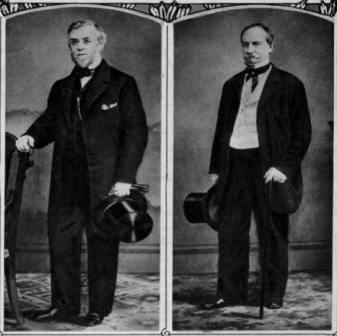An ephemeris of materia medica, pharmacy, therapeutics and collateral information. Brooklyn: Charles F. Squibb, 1883-1906. Vols. 1 & 2.
 Edward Robinson Squibb received his medical degree in 1845, and served as a naval surgeon from 1847-1857, where he was eventually became assistant director of the U.S. Naval Laboratory in New York. While in the service, he was exposed to the negative effects that impure medicines and drugs of variable quality have on both patients and the efficiency of the medical department. As biographer Lawrence Blochman notes, “Uniformity and purity became a lifetime passion with Dr. Squibb, a crusade which was to embrace all pharmacy” (Blochman viii). In 1856, Squibb invented an ether still apparatus that allowed for the production of better quality ether of more consistent strength and purity. His new process for distilling ether with live steam also made its use much safer, since an open flame was no longer needed to process the highly volatile chemical (Blochman vii-viii). The effectiveness of anesthesia was greatly improved by Squibb’s device. This was very fortunate to have by the war’s beginning.
Edward Robinson Squibb received his medical degree in 1845, and served as a naval surgeon from 1847-1857, where he was eventually became assistant director of the U.S. Naval Laboratory in New York. While in the service, he was exposed to the negative effects that impure medicines and drugs of variable quality have on both patients and the efficiency of the medical department. As biographer Lawrence Blochman notes, “Uniformity and purity became a lifetime passion with Dr. Squibb, a crusade which was to embrace all pharmacy” (Blochman viii). In 1856, Squibb invented an ether still apparatus that allowed for the production of better quality ether of more consistent strength and purity. His new process for distilling ether with live steam also made its use much safer, since an open flame was no longer needed to process the highly volatile chemical (Blochman vii-viii). The effectiveness of anesthesia was greatly improved by Squibb’s device. This was very fortunate to have by the war’s beginning.
Squibb left the navy in 1857 and set up a private pharmaceutical laboratory in Brooklyn, New York. Though he had already completed his military service before Civil War, Squibb did play an important part of the war effort by supplying pure, quality ether, chloroform and a variety of other medicines to the U.S. Army. He was also responsible for designing a new kind of light-weight pannier box (or medicine chest) which was used to distribute medicines to doctors working in the field (Smith 13-14). Essential to the establishment of Squibb’s lab as one of the primary army pharmaceutical suppliers was his good working relationship with military medical leaders. Chief purveyor for the U.S. Army, Richard S. Satterlee (1789-1880), impressed with the quality and skill of Squibb’s work, was responsible for many of the orders and contracts Squibb received from the army. After the war’s start, Satterlee requested that Squibb expand his laboratory to fill more of the army needs. Adequately convinced that the war would not be over in just a few months like many thought, Squibb re-located to a newly constructed two-story facility, and from there he supplied about one-twelfth of the army medical stores (Flannery 106). However, the army continued to need more and more supplies, and it was not long before government laboratories were set up to fill in the gaps of private industry. Now Squibb and other pharmaceutical manufacturers had competition to face. But in the end, government labs only supplemented private suppliers instead of destroying them as some feared (Flannery 114). In fact, the Civil War helped Squibb start what became a very successful pharmaceutical company, the Squibb Corporation, which is still thriving today. Also during the war, Squibb authored many articles in pharmacy journals, especially the American Journal of Pharmacy. The Reynolds-Finley Historical Library holds all war-year volumes of this publication.
After the Civil War, Squibb’s company emerged as a leader in the industry, a status it continued to hold after Squibb’s death in 1900. In addition to his highly-regarded business, Edward Squibb was also known for what Lawrence Blochman calls his “rugged idealism”. He was committed to pure, quality pharmaceutics manufactured and distributed to high professional and ethical standards. Never patenting his discoveries and inventions, Squibb held onto the notion that anyone who wished to use them to benefit mankind should have the ability. And he took up the cause of revising and completely revamping the United States Pharmacopoeia, a standard reference in the field. When the American Medical Association rejected his suggestion, Squibb founded a publication that could live up to his standards, An ephemeris of materia medica, pharmacy, therapeutics and collateral information. Although his two sons were named co-editors, most of the articles within this journal were written by Squibb himself. Distributed to professionals free of charge, this journal evaluated medicines, apparatuses and techniques, and was critical of greedy quacks (Florey xx; Blochman viii-ix). Issues were published every two months in order to keep professionals abreast of new developments throughout the year (Blochman 299). The Reynolds-Finley Historical Library holds the first two bound volumes of Squibb’s publication from 1882/1883 and 1884/1885.
Image: Edward R. Squibb (pictured left) in 1864 alongside medical purveyor Richard S. Satterlee. Courtesy of the American Institute of the History of Pharmacy, Madison, Wisconsin.
